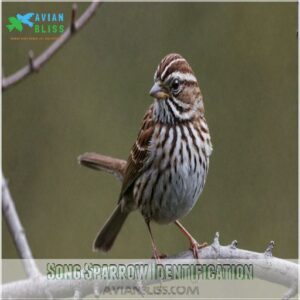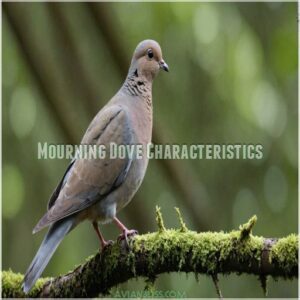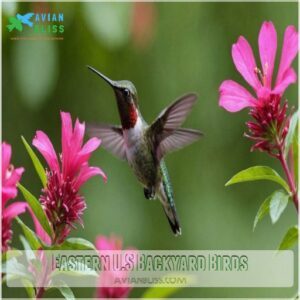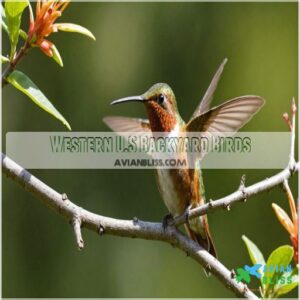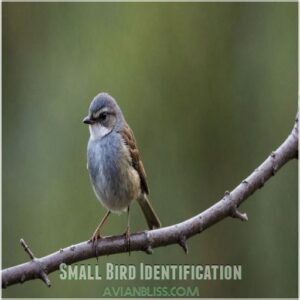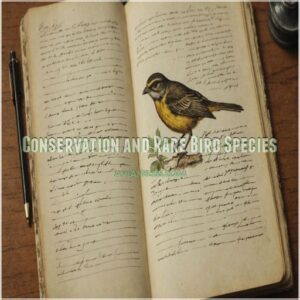This site is supported by our readers. We may earn a commission, at no cost to you, if you purchase through links.
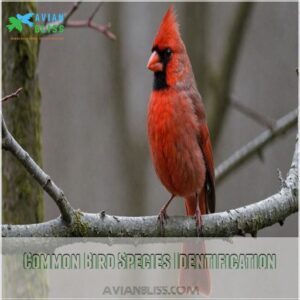 You’ll find that common bird species identification isn’t just for seasoned birders – it’s a skill anyone can master.
You’ll find that common bird species identification isn’t just for seasoned birders – it’s a skill anyone can master.
Start by observing key features: size, shape, color patterns, and behavior.
Is that visitor sparrow-sized or crow-sized?
Notice distinctive traits like the Northern Cardinal’s vibrant red plumage or the Blue Jay’s striking blue crest.
Your backyard regulars will become as familiar as neighbors over time.
Focus on common species first, using field guides or apps to confirm your hunches.
Like learning to recognize friends by their walk or laugh, you’ll soon pick up on the subtle differences between feathered visitors.
Bird identification opens up a world of fascinating behaviors and seasonal patterns.
Table Of Contents
- Key Takeaways
- Common Bird Species Identification
- Backyard Birds Across The U.S
- Eastern U.S Backyard Birds
- Western U.S Backyard Birds
- Bird Identification Basics
- Identifying Raptors and Large Birds
- Small Bird Identification
- Tips for Observing and Identifying Birds
- Conservation and Rare Bird Species
- Frequently Asked Questions (FAQs)
- How do I tell what kind of bird I found?
- Is there a website to identify birds?
- Is there an app that identifies birds?
- How can I identify a bird quickly?
- How do birds survive extreme weather conditions?
- What determines the color of bird eggs?
- Can birds recognize individual human faces?
- Why do some birds migrate at night?
- How long do different bird species typically live?
- Conclusion
Key Takeaways
- You’ll identify birds more easily by focusing on key features like size, shape, color patterns, and behavior – start with common species in your backyard before tackling rarer ones.
- You’ll need the right tools for successful birding – quality binoculars for observation, strategically placed feeders to attract birds, and a journal to record your sightings and patterns.
- You can distinguish between similar species by learning their unique characteristics – for example, male cardinals are bright red while females are brownish, and chickadees have distinctive black caps and calls.
- You’ll enhance your birding experience by understanding habitats and seasonal patterns – different birds prefer specific environments, and many species change their behavior and appearance throughout the year.
Common Bird Species Identification

In your birdwatching adventures, identifying common species like the Northern Cardinal or the American Robin can enhance your outdoor experience.
You’ll quickly learn to recognize key features, such as the vibrant red of a male cardinal or the rusty belly of a robin, turning every encounter into a chance to hone your skills.
Northern Cardinal Characteristics
Spotting a Northern Cardinal is like finding a gem in your backyard. With striking colors and delightful songs, they captivate bird enthusiasts.
- Male vs. Female: Males boast vibrant red feathers, while females sport softer shades.
- Cardinal Diet: They love sunflower seeds.
- Cardinal Range: Found across North America.
- Cardinal Nesting: Dense shrubs offer perfect homes.
Blue Jay Identification
Have you ever marveled at the Blue Jay’s striking blue plumage and curious behavior?
These North American birds are more than just pretty to look at!
Known for their mimicry skills and varied calls, they thrive on a diverse diet.
Here’s a quick guide:
| Feature | Example |
|---|---|
| Plumage | Vibrant blue |
| Mimicry | Red-shouldered Hawk scream |
| Habitat | Suburban areas |
Red-tailed Hawk Features
After learning about Blue Jays, turn your gaze to the skies where the Red-tailed Hawk commands attention.
With their striking markings and majestic flight, these hawks are a bird identification favorite.
Look for these features:
- Diet: Mostly small mammals and rodents.
- Habitat: Open country and woodlands.
- Call: A piercing scream, iconic among hawk identification.
American Robin Distinctive Traits
Recognizing American Robins is easier than you think!
They’re common backyard birds, perfect for bird watching beginners.
Here’s a handy guide:
| Feature | Description |
|---|---|
| Plumage Differences | Males have brighter orange breasts. |
| Nest Placement | Often in trees or shrubs, low to the ground. |
| Song Variations | Cheerful, melodic warbles; varies slightly. |
Seasonal changes affect their behavior; some northern robins migrate south for winter.
Bird identification becomes a breeze with practice!
Backyard Birds Across The U.S
When you peer out into your backyard, there’s a whole world of fascinating birds waiting for you to discover.
From the friendly chirps of the Song Sparrow to the gentle coos of the Mourning Dove, each species adds its own touch to the natural tapestry across the U.S.
Song Sparrow Identification
You might find yourself puzzling over a small, streaked bird in your backyard.
Meet the song sparrow, known for its delightful song and varied habitat preferences.
To attract birds like the song sparrow, consider adding sunflower seeds to your yard, a favorite of many common backyard birds.
With plumage ranging in shades and patterns, it presents identification challenges.
Rely on bird identification guides for distinguishing features and enjoy learning native bird species‘ bird songs and calls in your own space.
Black-capped and Carolina Chickadees
Spotting chickadees adds a song to your birding adventure.
These lively birds, known for their chick-a-dee-dee-dee calls, are masters of quick, agile movements.
Black-capped and Carolina Chickadees share similar looks but differ subtly in range and behavior.
When identifying woodpeckers, observe their distinctive drumming sounds and calls, such as the Downy’s high-pitched whinnying, as discussed in woodpeckers in New Hampshire. Keep an eye on their nesting habits and diet preferences.
Understanding the distinctive habits of larger bird species, such as the size and shape differences between red-tailed vs red-shouldered hawks, can also improve your bird identification skills. You’ll enhance your bird identification skills by understanding these cheery songbirds’ behaviors and habitats.
Mourning Dove Characteristics
Listening closely, you’ll hear the Mourning Dove’s soft, mournful calls—a signature mourning song that fills many backyards.
These gentle birds prefer open habitats, thriving in both rural and urban settings.
Their diet, mainly seeds, keeps them grounded, quite literally.
Watch for their swift, steady flight and you’ll notice their distinctive long tails.
Their dedicated nesting habits are a marvel in the bird world.
Eastern U.S Backyard Birds
In your Eastern U.S. backyard, you’ll likely encounter the delightful Ruby-throated Hummingbird, known for its agile flight and vibrant plumage.
Carolina Wren and the iconic Northern Cardinal, each with its unique habitats and charming behaviors.
Ruby-throated Hummingbird Identification
Flocks of color and melody can brighten any morning with charm.
The Ruby-throated Hummingbird, a dazzling gem in the Eastern U.S., steals the show.
Look for its vibrant throat, quick wingbeats, and tiny stature.
It buzzes from flower to feeder, reflecting its wide range and variety of food sources.
Consider using Bird Identification Apps to enhance your birding adventure.
Carolina Wren Distinctive Traits
The American Goldfinch, with its vibrant summer plumage and distinctive black wing bars, is often a striking sight. Tiny but tenacious, the Carolina Wren is a common backyard bird. You’ll recognize it by its distinctive features.
- A loud, bubbly song, often described as a "teakettle" sound.
- A reddish-brown back and a long, cocked tail.
- A preference for dense shrubs and woodlands.
Learning to identify this small bird enhances your birding skills.
Its Conservation Status is secure, making it a joy to observe.
Northern Cardinal Habitats
While appreciating Carolina Wrens’ lively songs, you might spot the Northern Cardinal, which adds a splash of red to your yard.
You can find more information about birds with vibrant colors, such as the blue birds with orange chests Eastern Bluebird Characteristics, including their identification and habitat preferences. You can find more information about the Northern Cardinal, including its identification and habitat preferences, in a detailed bird field guide.
Cardinals thrive in various habitats—from urban backyards to lush woodlands.
Offering sunflower seeds at feeders can help attract these beauties.
Keep an eye out for nests tucked in dense shrubs, as habitat changes pose threats to their cozy homes.
Western U.S Backyard Birds
In the western U.S., your backyard offers a stage for fascinating bird species like the vibrant Rufous Hummingbird and the charming Spotted Towhee.
Checking out these avian visitors can turn even a quick peek outside into an exciting mini-adventure, easily adding a little color to your day.
Rufous Hummingbird Characteristics
Imagine a jewel-toned traveler, the Rufous Hummingbird fascinates with its fiery plumage.
Known for its ambitious migration patterns, it covers miles rivaling any road trip.
These birds can be found passing through western Texas during their seasonal travels as part of their hummingbirds in Texas migration route.
Its diet consists mainly of nectar but don’t be surprised if it samples insects, too.
These tiny acrobats exhibit territorial behavior with sharp vocalizations defending their space from Blue Jays, American Crows, and others.
Spotted Towhee Identification
Meet the Spotted Towhee, a striking backyard bird in the Western U.S.
You’ll find these ground-dwelling beauties scratching through leaf litter for tasty morsels.
Here’s what you need to know:
- Range: Western states, from coastal regions to mountain forests
- Song: Cat-like mew followed by a rapid trill
- Sexes: Males sport a jet-black hood, females are brown
- Habitat: Shrubby areas, forest edges, and chaparral
- Diet: Insects, seeds, and berries
Keep your eyes peeled near dense undergrowth for these feathered jewels!
Lesser Goldfinch Features
The Lesser Goldfinch is a small, vibrant bird you’ll spot in Western backyards.
Males sport a striking black cap and bright yellow underparts, while females are more olive-green.
Their diet consists mainly of seeds, especially from sunflowers and thistles.
Listen for their sweet, warbling song, often given in flight.
These social birds form small flocks, making them a joy to observe at feeders or in native plant gardens.
Bird Identification Basics
You’ll soon unravel the mysteries of bird identification by focusing on key traits like feathers, beak shape, and behavior.
These characteristics act as puzzle pieces, helping you piece together the identity of your feathered friends with increasing confidence and accuracy.
Feathers and Plumage
Feathers and plumage are birds’ calling cards, offering a window into their world.
You’ll find that plumage variation can be a game-changer in bird ID.
Take the Steller’s Jay’s vibrant blue feathers or the Black-billed Magpie’s iridescent tail.
Molting patterns add another layer of complexity.
You can find a great resource for learning more about these patterns in a detailed bird identification guide.
Marvel at the Dark-eyed Junco‘s regional color morphs.
Admire the Black-capped Chickadee‘s contrasting cap and bib.
Notice the White-breasted Nuthatch’s subtle blue-gray back.
Feather adaptations aren’t just for show—they’re survival tools.
Beak Shape and Size
Beaks are nature’s Swiss Army knives, evolved to perfectly suit a bird’s diet.
You’ll spot conical beaks on seed-eaters like the Tufted Titmouse, while the Hairy Woodpecker sports a chisel-like bill for drilling.
The Red-bellied Woodpecker‘s sturdy beak extracts insects from bark.
Eagles boast hooked beaks for tearing prey, while falcons have a notched upper mandible for efficient killing.
These beak adaptations reflect millions of years of evolution, fine-tuning each species’ feeding habits.
Bird Behavior and Habitat
Habitat hotspots and behavioral cues offer key insights into bird identification.
You’ll notice seasonal variations in bird migration patterns and nesting habits.
Food sources influence where you’ll spot different species, while territorial behavior can reveal a bird’s identity.
Watch for herons stalking fish in wetlands or bitterns blending into reeds.
By observing these patterns, you’ll become a savvy birdist in no time.
Identifying Raptors and Large Birds
You’ll find that identifying raptors and large birds requires a distinct set of skills, as these majestic creatures often present unique challenges.
By focusing on key features like size, flight patterns, and distinctive markings, you can distinguish between common species such as the Red-tailed Hawk, Great Horned Owl, and Golden Eagle.
Red-tailed Hawk Identification
You’ll spot Red-tailed Hawks circling overhead with their distinctive broad wings and rusty-red tail.
These impressive raptors, found across North America’s open spaces, range from 18-26 inches in size.
Listen for their iconic raspy scream, often borrowed in movies for eagle sounds.
They’re adaptable hunters, perching on poles while scanning for prey like rabbits and rodents, making them easy to observe and identify.
Great Horned Owl Characteristics
When dusk settles over North America’s diverse landscapes, the great horned owl emerges as a masterful predator.
These fierce hunters dominate their territories with remarkable adaptability across varied habitats.
- Distinctive ear tufts stand tall like horns above piercing yellow eyes
- Deep hooting calls echo through forests: "Who’s awake? Me too"
- Powerful talons can crush prey with 500 pounds of force
- Neck rotation reaches 270 degrees for superior hunting
Golden Eagle Distinctive Traits
Moving from nocturnal hunters to masters of the sky, golden eagles stand out among North American raptors.
Their impressive wingspan stretches up to 7.5 feet, making them true aerial champions.
These majestic birds soar effortlessly on thermal currents, scanning vast territories for prey.
Look for their distinctive dark brown plumage and golden-tinged head feathers that catch the sunlight.
| Feature | Description |
|---|---|
| Flight Pattern | Steady soaring, wings in slight V-shape |
| Diet | Small mammals, birds, carrion |
| Juvenile ID | White wing patches, tail base |
Small Bird Identification
You’ll find that smaller birds like chickadees, juncos, and finches present unique identification challenges due to their quick movements and subtle markings.
When you’re observing these diminutive creatures, you’ll need to focus on their distinctive features such as wing bars, crown patterns, and bill shapes to make an accurate identification.
Chickadees and Titmice
These cheerful little acrobats of the bird world bring life to any backyard.
While larger birds command attention from afar, chickadees and titmice steal the show up close with their distinctive calls and bold personalities.
Their winter feeding habits make them regular visitors to feeders, where they dart in for sunflower seeds and suet with remarkable agility.
- Black-capped chickadees announce themselves with their unmistakable "chick-a-dee-dee-dee" call, adding more "dees" when they’re alarmed
- Tufted titmice prefer nesting in natural tree cavities but will happily claim nest boxes near reliable food sources
- Both species cache food for later use, remembering hundreds of hiding spots throughout their territory
Dark-eyed Juncos and Sparrows
Dark-eyed juncos and sparrows are nature’s ultimate backyard companions.
You’ll spot juncos flashing their white tail feathers as they hop beneath your feeders, while sparrows belt out their distinctive songs from nearby shrubs.
Sparrows, with their robust bodies and stout bills, such as the House Sparrow species, have adapted to urban environments and can be seen thriving in a variety of settings.
Their range stretches across varied habitats, from mountain forests to suburban gardens.
| Species | Key Features | Preferred Habitat |
|---|---|---|
| Junco | White belly, dark hood | Forest edges |
| Song Sparrow | Streaked breast, central spot | Dense shrubs |
| Field Sparrow | Pink bill, rusty crown | Open grasslands |
Finches and Their Characteristics
Finches bring a lively splash of color to your backyard, with their distinct cone-shaped beaks perfect for cracking seeds.
While juncos prefer ground feeding, finches showcase their acrobatic skills at feeders.
You’ll spot these charming birds by:
- Their varied songs, from sweet trills to buzzy warbles
- Seasonal plumage changes, especially in males
- Social behavior at feeders, where they gather in small flocks
These musical acrobats add joy to any birding adventure.
Tips for Observing and Identifying Birds
You’ll find that identifying birds becomes easier when you use the right tools and techniques, including quality binoculars, strategically placed feeders, and detailed field notes.
With proper observation methods and consistent practice, you can transform from struggling to tell apart similar species to confidently spotting the subtle differences between a Song Sparrow and a House Finch.
Binoculars and Spotting Scopes
Quality optics are your gateway to the avian world.
When choosing binoculars, consider magnification and objective lens size.
An 8×42 pair offers a good balance of power and field of view.
For distant birds, a spotting scope is invaluable.
Remember to clean lenses gently with a microfiber cloth.
With practice, you’ll be zeroing in on feathered friends like a pro, revealing nature’s hidden wonders.
Bird Feeders and Bird Baths
Now that you’ve got your binoculars ready, let’s set up a bird buffet in your backyard.
Choose a sturdy bird feeder design and place it where you can easily observe.
For a spa day, add a bird bath in a shaded spot.
Keep both clean to prevent disease.
Different seeds attract various species, so mix it up.
You’ll have a bird party in no time!
Birding Journaling and Note-taking
Keeping a birding journal is like creating a personal field guide.
You’ll want to jot down details about the birds you spot, including their appearance, behavior, and habitat.
Use birdwatching apps to record sightings and compare notes with field guides.
Try sketching birds to sharpen your observation skills.
Develop a journaling format that works for you, whether it’s a structured checklist or freeform notes.
These bird ID tips will help you become a more skilled birder over time.
Conservation and Rare Bird Species
As you explore bird species, you’ll encounter rare birds facing threats to their survival.
By understanding these challenges and supporting conservation efforts, you can play a vital role in protecting endangered avian populations for future generations to enjoy.
Threats to Bird Populations
While you’re out spotting birds, it’s important to understand the challenges they face.
Habitat loss shrinks their homes, and climate change alters their natural rhythms.
Pesticides poison their food sources, while invasive species compete for resources.
Even diseases can spread through bird populations.
These threats aren’t just hurting individual birds – they’re reshaping entire ecosystems.
By learning about these issues, you’ll be better equipped to help protect our feathered friends.
Endangered and Rare Bird Species
As habitat loss and climate change intensify, some bird species face a perilous future.
You might spot the elusive Kirtland’s Warbler or the striking California Condor on your birdwatching adventures.
These rare birds, once on the brink of extinction, now serve as living examples of successful conservation efforts.
Keep your eyes peeled for these feathered treasures – they’re like nature’s hidden gems, waiting to be discovered by keen observers like you.
Bird Conservation Efforts and Organizations
Bird conservation efforts are soaring to new heights, thanks to dedicated organizations and passionate individuals like you.
You can make a real difference in protecting our feathered friends.
For instance, learning about the Migratory Bird Treaty Act can help you understand the laws in place to safeguard bird populations.
Here’s how you can get involved:
- Support bird sanctuaries by volunteering or donating
- Participate in citizen science projects to gather valuable data
- Join habitat restoration initiatives in your local area
- Form conservation partnerships with like-minded groups
Together, we’re giving endangered species a fighting chance and ensuring our skies remain filled with birdsong for generations to come.
Frequently Asked Questions (FAQs)
How do I tell what kind of bird I found?
Look for key features like size, color patterns, beak shape, and behavior.
You’ll need to observe carefully – notice the habitat and listen for calls.
A field guide or bird ID app can help confirm your findings.
Is there a website to identify birds?
You’ll find great bird ID help on the Merlin Bird ID app and Cornell’s All About Birds website.
They’ll guide you through visual features, songs, and locations to pinpoint your feathered friend.
Is there an app that identifies birds?
Several popular apps can identify birds instantly.
Merlin Bird ID, created by Cornell Lab, provides accurate photo and sound identification.
Identifying white birds with black tipped wings can be a challenge, but checking out the guide on white birds with black tipped wings can help. It’s free, user-friendly, and includes detailed species guides for confident bird watching.
How can I identify a bird quickly?
Focus on key features: size, color, and behavior. Notice the bird’s shape, beak type, and where you spot it. These clues quickly narrow down possible species, making identification a breeze.
How do birds survive extreme weather conditions?
Birds adapt brilliantly to harsh weather.
They’ll fluff their feathers for insulation, huddle together for warmth, and find sheltered spots.
Some even lower their body temperature at night to conserve energy – nature’s thermostat!
What determines the color of bird eggs?
Nature’s palette determines the hue of avian offerings!
You’ll find that pigments in a mother bird’s blood create unique egg colors, while shell structure affects patterns – it’s all about genetics and survival strategy.
Can birds recognize individual human faces?
You might be surprised, but some birds can remember your face!
They’ll spot you coming and react based on past encounters.
Crows are especially skilled at this – they’ll hold grudges or show affection depending on your history.
Why do some birds migrate at night?
In the vast nocturnal sky, millions of feathered travelers take flight.
They’ll find cooler temperatures, calmer air currents, and fewer predators.
Plus, they can use stars for navigation – it’s their secret nighttime superhighway!
How long do different bird species typically live?
Birds live surprisingly diverse lifespans. Small songbirds typically reach 2-3 years, while larger species like cardinals can hit You’ll find owls lasting 20+ years, and parrots might outlive you at 50+!
Conclusion
With over 900 bird species in North America, mastering common bird species identification opens up endless opportunities for discovery.
You’ll find that starting small – learning your backyard visitors first – builds confidence and skills naturally.
As you practice, you’ll pick up the subtle differences in wing patterns, calls, and behaviors that make each species unique.
Whether you’re a casual observer or aspiring ornithologist, the joy of correctly identifying birds never fades.
Knowing the characteristics of common songbirds in your area, such as the Pacific Northwest common songbirds of the pacific northwest, can greatly enhance your birding experience. Keep your eyes sharp and your field guide handy – your next exciting bird species identification is just around the corner.

